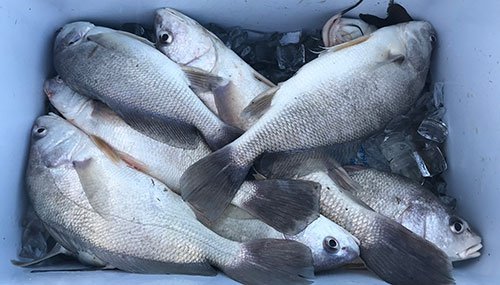Drumming up spring fishing excitement
BY Chuck Long
ON 04-01-2020

April 1, 2020
Chuck Long
AGFC Northeast Regional Educator, Jonesboro

JONESBORO — Many spring anglers turn their thoughts to a wonderful silver-hued fish, the crappie. Another silver fish is readily available to anglers throughout The Natural State and provides a great angling opportunity. Freshwater drum often is overlooked by anglers, despite its hard fight, potential to reach large sizes and fine table quality.
Drum are found throughout Arkansas in most flowing waters and larger lakes. They primarily feed on the bottom, looking for crayfish, macroinvertebrates and small fish. They are not very selective feeders, which makes them an ideal target for anglers.
Any rod and reel can be effective for drum fishing. A basic spincasting rig will handle most drum, while a spinning rod or baitcasting setup can also be very effective. Monofilament line in the 15- to 20-pound range will be effective, but a better choice might be braided line in the 20- to 30-pound range. Drum are often found in deeper water with current and the thinner diameter of the braid lessens drag of the current while waiting on a bite.
Terminal tackle for drum fishing is simple. Begin the rigging with an egg sinker about ½-ounce or larger, depending on the current flow. Slide the main line through the egg sinker and then tie on a barrel swivel, which will allow the sinker to slide freely up and down the main line. Attach a monofilament leader of about 12 inches to the swivel and tie on a hook. Drum have a relatively small mouth so a small hook is typically better. Baitholder-style hooks in the no. 2 or 4 size are very effective. Drum are very prone to light bites and swallowing the bait so a circle hook can also be a great tool. Circle hooks in a light wire no. 1 with a wide bend are very effective. When using a circle hook, there is no need for a sharp hook set, just tighten up the slack and pressure will allow the circle hook to penetrate into the corner of the fish’s mouth.
Drum can be caught on a variety of baits, but there have probably been more caught on worms than any other. Crawdad tails and pieces of cooked shrimp can also be very effective. Drum often are incidental catches by bass or crappie anglers, as they also will strike artificial baits like small grubs, swimbaits and jigs that are fished near the bottom.
As with most fish, being able to read the water is critical to catch drum. Current breaks, eddies, dropoffs and structure will hold drum. Anchor above a likely area, cast out several rods to cover multiple depths, sit back and wait for the bite. Drum are great for bank anglers as they are very accessible from shore. Read the water, set out a few rods and get ready for a tug on the line. Drum will provide a great fight for any angler and are especially good for young anglers because they can provide lots of action. They often travel in schools, so once a fish is caught concentrate on that area.
Drum are often seen as subpar for the table but this is far from the truth. When caught out of cool water, they are excellent additions to a meal. Ice the fish as soon as possible and fillet them just as you would bass or crappie. There are no intermuscular bones, and the meat is firm. With a little trimming of the dark red meat just under the skin, drum can be prepared in a variety of ways. Drum fillets are good for the traditional fish fry with a covering of seasoned cornmeal and immersion in oil at 350 degrees for about six minutes. Like their saltwater cousins, the redfish, they are also excellent with a blackened recipe. The texture and consistency also lends itself to a unique recipe, poor man’s lobster. There are many variations to this recipe, but the basics are to cube the fillets into bite-sized pieces, boil for 5 to 7 minutes in crab boil seasoning and serve with a butter-based dipping sauce. It makes for a great appetizer or main meal.
Chuck Long is a regional educator based at the AGFC’s Forrest L. Wood Crowley’s Ridge Nature Center. He has taught hunting, fishing and enjoyment of Arkansas’s outdoors for 30 years.
Recent News

Arkansas Wildlife Weekly Fishing Report
Jun. 26, 2025

2025-26 Federal Duck Stamp reveal Friday
Jun. 26, 2025
Subscribe to Our Weekly Newsletter E-mails
Don’t miss another issue. Sign up now to receive the AGFC Wildlife Weekly Newsletter in your mailbox every Wednesday afternoon (Waterfowl Reports are published weekly during waterfowl season and periodically outside the season). Fishing Reports arrive on Thursdays. Fill in the following fields and hit submit. Thanks, and welcome!
